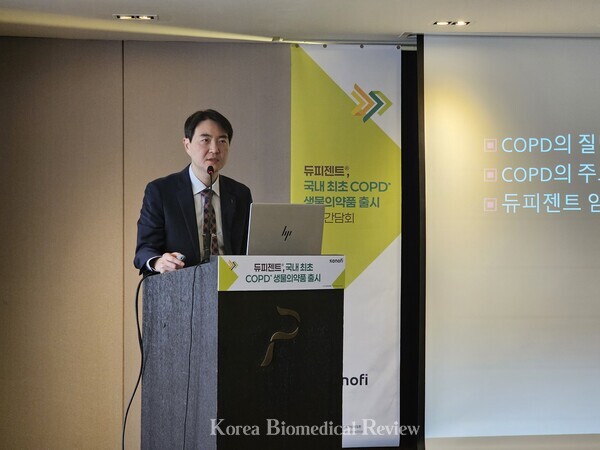Sanofi’s Dupixent (ingredient: dupilumab) has officially expanded its treatment scope in Korea to include chronic obstructive pulmonary disease (COPD), becoming the country’s first approved biologic therapy for the condition.
With the latest regulatory approval granted on March 13, Dupixent is now indicated as an add-on maintenance treatment for adult COPD patients with elevated blood eosinophils who are inadequately controlled with standard inhaled therapies.
The company held a press conference on Wednesday to introduce the newly approved indication and share updated clinical insights with the medical community and media. The event featured respiratory disease expert Professor Rhee Chin-kook of the Department of Pulmonology at Seoul St. Mary’s Hospital, who emphasized the unmet medical need in COPD and highlighted the potential of Dupixent to reshape treatment strategies.

"Despite the increasing prevalence of COPD and its socioeconomic burden—estimated at 1.4 trillion won ($943.5 million) annually—the disease remains largely underdiagnosed and undertreated in Korea," Professor Rhee said. “We estimate that there are about 3 million potential COPD patients, yet only around 100,000 are currently being treated.”
Adding to the challenge is the fact that COPD symptoms typically do not appear until more than 50 percent of lung function is lost, and once symptoms emerge, disease progression accelerates, and lost lung capacity cannot be recovered—making early diagnosis and intervention critical.
Lee explained that many COPD patients continue to suffer from repeated acute exacerbations even after triple inhaler therapy, particularly those with elevated eosinophil counts driven by type 2 inflammation.
“This population faces higher risks of hospitalization, readmission, and cardiovascular complications, underscoring the need for targeted treatments,” he said. “Korea’s clinical guidelines recommended Dupixent for use even before it received regulatory approval—a move that reflects strong demand from the medical field and patients.”
Lee called this early recommendation highly unusual and said it highlights both the level of unmet need and the anticipation for new treatment approaches in COPD.
“Dupixent is a timely addition to the therapeutic arsenal, particularly for those with severe and uncontrolled COPD,” he said. “The drug's ability to inhibit IL-4 and IL-13 signaling addresses the root inflammatory mechanism in this subgroup.”
The professor also emphasized that Dupixent showed clinical benefits regardless of patient age or baseline lung function, making it a valuable option for diverse cases.
Despite the promising development, Lee stressed that policy support remains essential.
“Adding pulmonary function testing to national health screenings and enhancing chronic disease management policies would be critical to improving early diagnosis and access to treatment for COPD patients,” he said.
Sanofi General Manager Pharma Multi-Country Office South Korea and Australia/New Zealand & MCO Lead Bae Kyung-eun also said, “Many patients still struggle with uncontrolled symptoms despite triple inhaler therapy.”
Dupixent, through its immune-based approach, offers not only symptomatic relief but also a new path forward in COPD treatment, Bae added.
Related articles
- Sanofi launches new cholesterol-lowering injection in Korea with health insurance coverage
- Sanofi Korea wins approval to expand Dupixent indication for certain COPD patients
- Sanofi launches Beyfortus, an antibody shot to prevent RSV, in Korea
- Sanofi’s Rezurock marks turning point in treating blood cancer complication, GVHD
- Sanofi wins Korea nod for 3-strain flu vaccines as one virus strain drops from global use
- LEO goes after Dupixent’s weak links, but Korea bars switching between biologics
- Sanofi Korea and SNUH collaborate to drive digital transformation in clinical trials
- Sanofi hosts event to empower young adults living with Pompe disease

